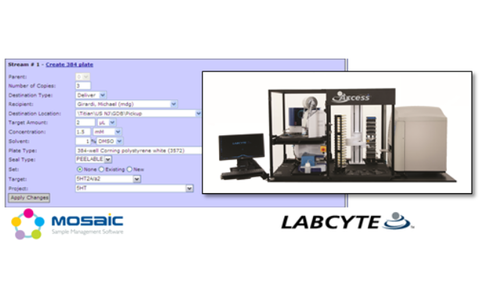
A collaboration between Labcyte and Titian has developed an improved system for miniturised assay development.
Labcyte and Titian have announced an integration of the Mosaic sample management suite with the Access workstation and POD automation platform – two Labcyte automation systems incorporating the Echo liquid handler.
Mosaic manages and tracks sample libraries with improved sample preservation and viability. Requestors can select individual substances, plates or substance sets for assay.
It allows assay plate formats to be defined and easily managed. Mosaic requests can also be configured as templates to precisely and repeatedly match the requirements of particular assays.
The order workflow is managed, ensuring that the correct items are brought to Labcyte systems to begin assay-ready plate preparation.
Labcyte automation systems incorporate Echo liquid handlers into small- and large- scale systems for walk-away sample processing.
Since the Echo liquid handler does not require the use of pipette tips, pin tools or nozzles it provides unsurpassed precision and accuracy. With a range of device options and accessories, Labcyte automation systems adapt to the ever?changing needs of assays in drug discovery, genomics, proteomics, and more.
Titian provides a driver module that transfers instruction files to the Labcyte Tempo automation control software – an intuitive platform to develop protocols for the Access and POD systems.
At the end of each acoustic transfer, the resulting changes in the inventory (including acoustic surveys of source well contents) are reflected in Mosaic, using the results data generated on the Labcyte systems, without operator interaction.
Labcyte Tempo software manages all tasks including system setup as well as all plate and liquid handling activities. After plate loading and sample transfer, the assay ready plates are sealed or lidded and stacked ready for delivery.
In addition to low volume plate replication and hit picking, the ability of the Echo system to transfer samples in as little as 2.5 nL permits a direct dilution of samples for dose-response assays; eliminating the cross-contamination and error propagation seen with traditional serial dilution methods.




